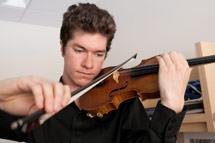
Handy Links
SLAC News Center
SLAC Today
- Subscribe
- Archives: Feb 2006-May 20, 2011
- Archives: May 23, 2011 and later
- Submit Feedback or Story Ideas
- About SLAC Today
SLAC News
Lab News
- Interactions
- Lightsources.org
- ILC NewsLine
- Int'l Science Grid This Week
- Fermilab Today
- Berkeley Lab News
- @brookhaven TODAY
- DOE Pulse
- CERN Courier
- DESY inForm
- US / LHC
SLAC Links
- Emergency
- Safety
- Policy Repository
- Site Entry Form

- Site Maps
- M & O Review
- Computing Status & Calendar
- SLAC Colloquium
- SLACspeak
- SLACspace
- SLAC Logo
- Café Menu
- Flea Market
- Web E-mail
- Marguerite Shuttle
- Discount Commuter Passes
-
Award Reporting Form
- SPIRES
- SciDoc
- Activity Groups
- Library
Stanford
Around the Bay
People: Peter Behroozi's Sonata
Search for the name "Peter Behroozi" online, and you get even more YouTube hits than links to the SLAC astrophysicist's half-dozen research papers on lasers and star formation.
That's because the 25-year-old graduate student is a violin performer and composer when he's not simulating galaxies on his laptop. He debuted his first violin sonata in January at Stanford, a 15-minute classical composition that starts serene and calm, he said, before breaking into "crazy jazz rhythms." Behroozi, previously concertmaster of the Stanford Philharmonic Orchestra, is already writing another sonata for next year.
Despite practicing anywhere from two to eight hours every day, Behroozi said he's never had a problem balancing music and his research in astrophysics. When push comes to shove, he said, physics comes first.
"If I wanted to be a professional musician, I'd be really poor," Behroozi said. That's just modesty, according to his fellow musician Cynthia He, who says he'd probably be able to pull off a solo career just as well as his physics one.
"Peter's fantastic," said He. "He's always thinking of how to make something expressive and he's intensely musical."
Behroozi started writing the sonata in September in a practice room in the Stanford music building, juggling a violin while also trying out harmonies on piano. He scratched notes out on paper at night and on weekends, even sneaking lunch and dinner in with him when the building was technically closed. The process wasn't quick—Behroozi averaged two or three measures each hour. He finished the piece only two weeks before show time, during Christmas break.
"I was writing full time," Behroozi said.
When it's not crunch time for a recital, Behroozi is at his desk on the second floor of the Physics and Astronomy building at Stanford. He simulates galaxies as blue bubbles against a pitch black background. Under the influence of gravity and unseen clusters of dark matter, the blue spheres bop around his computer screen, often clumping in regions called superclusters. Stars are born from the dust and gas in the blue bubbles, he explains, but physicists aren't sure exactly how. Because galaxies take up at least 1021—a billion trillion—times more volume than a star, it's virtually impossible for a computer to track a single star from its dusty galactic beginnings to a twinkling furnace.
"No computer today can do that," Behroozi said.
Instead, Behroozi adopts a less memory-intensive approach: he looks at very young galaxies, as well as very old, about 13 billion years, to infer what galactic conditions are like through a galaxy's lifetime. This historical shortcut tells him about a star's changing environment.
For Behroozi, music and science are intertwined—perhaps not surprising for an astrophysicist whose first song was Twinkle, Twinkle, Little Star.
"The music helps me be a better physicist," Behroozi said. Making strides in his research happens in random bursts, while he can constantly make small improvements when practicing violin.
"When you get too far into a problem, it's hard to see the big picture. Music lets me take a step back."
—Marissa Cevallos
SLAC Today, April 21, 2010
